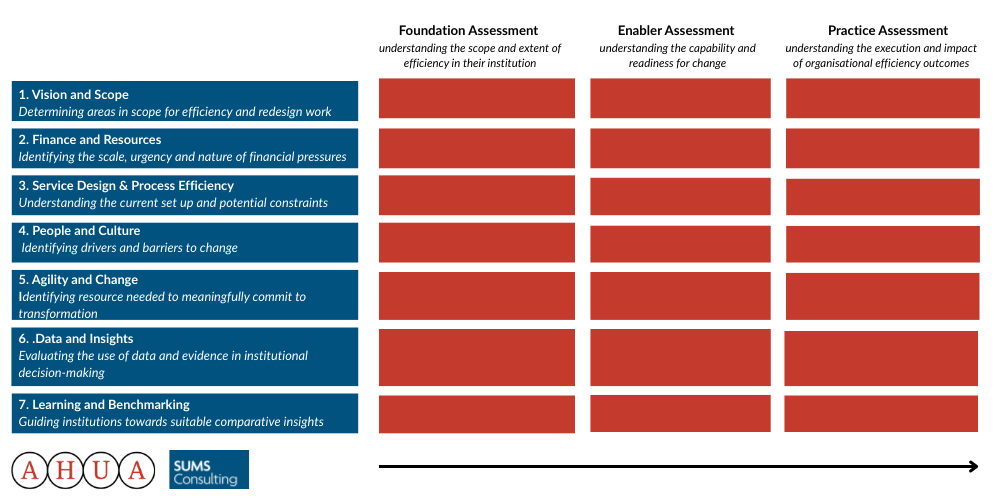Towards a Sector-wide Efficiency Maturity Model: Turning Collaboration into Transformation
Discover how a new model is helping UK universities move beyond short-term fixes to create a more collaborative and sustainable future for higher education.
Co-authored by Ben Vulliamy, Executive Director, AHUA, James Rolfe, Chief Operating Officer, Anglia Ruskin University, and Emma Ogden, Principal Consultant, SUMS Consulting

In July 2025, Universities UK (UUK) published ‘Transformation & Efficiency: Towards a new era of Collaboration’. Among its recommendations was a call for AHUA to lead work on an Organisational Efficiency Maturity Assessment (OEMA) model; a model that would enable institutions to ‘adopt a common approach to assessing efficiency and benchmarking costs.’
Since then, SUMS Consulting has been working with AHUA and a reference group with membership from 12 different institutions (including several representatives from the devolved nations) to shape the first iteration of this model. Chaired by James Rolfe (Anglia Ruskin Chief Operating Officer), supported by Ben Vulliamy (AHUA Executive Director) and with project lead Emma Ogden (SUMS Principle Consultant), the group has been working intensively over the summer to scope and design a minimum viable product model that we can launch before the end of the calendar year.
This blog offers an update on the progress and why the work matters.
Why this model is needed
The pace of change is quickening across the sector all the time. Universities face considerable financial pressures, but, arguably more importantly, they face real pressure to evolve models, provide better services which are more focused on student need, and to adapt the academic offer to make higher education attractive and value for money to as many people as possible. That after all will be key to the long-term success of our institutions and to the UK economy more generally.
So, a maturity model is designed to help us identify areas of strength and weakness within our institutions, how we compare to others, and to facilitate collaboration between institutions facing similar challenges and opportunities. It does not provide a silver bullet solution (and never will), but does, in our view help to understand where we are, and how we could improve further.
But what might this model look like, do and achieve?
A trusted mechanism for collaboration: The maturity model must help create trust and collaboration. Optimal maturity of efficiency will likely include an ability to partner and collaborate with others and so encouraging that in the application of the tool will be important. The executive and governing bodies must also appropriately steward the tool to guide people through the process of engagement.
A framework that balances competition with collective benefits: In such a competitive and regulated market, the associated CMA expectations may mean that how the data is used needs to be handled with care to ensure that its utilisation identifies suitable collaborative benefits and opportunities without being in breach of requirements about market manipulation. The model should point to opportunities without creating risks around compliance. And data-sharing where it is needed will of course be sensitive – building confidence in how information is treated is critical to the success of this model.
A whole-institution picture: Efficiency is not only about one area of the institution, but it must also extend across all services and directorates. The tool needs to avoid excessive granularity in favour of a focus on high-level institutional efficiency and maturity. A key hallmark of maturity is that assessments are coordinated centrally and understood and engaged with executive and board level.
A driver of transformation, not just savings: The tool should move away from ‘salami slicing’ and towards more deliberate, strategic choices for transformation and change. It should help institutions think about priorities for their strategy and opportunities for their organisational personality or business model to adapt and change that optimise the efficiency and high quality of the organisation.
A platform for sector learning: Beyond the beta launch, the model should involve picking up thoughts from colleagues (for example in BUFDG, UHR, HESPA etc) and also consider if and how the tool could reach further than UK HE. This will help the benefits of the total to grow and avoid being bound by our existing models and practice.
A catalyst for insight and practice: Once institutions are engaging, the opportunity shifts to produce case studies, sector insights, segmented workshops exploring partnership and collaborative opportunity etc. This will grow a body of collective learning that drives better decision-making across the sector.
What the model will cover
Through the reference group, seven lines of enquiry have emerged (outlined in the visual below), against three stages of maturity, which the OEMA would explore:

1. Vision and scope (determining areas in scope for efficiency and redesign work)
2. Finance and resources (identifying the scale, urgency and nature of financial pressures)
3. Service design and process efficiency (understanding the current setup and potential constraints)
4. People and culture (identifying drivers and barriers to change)
5. Agility and change (identifying resource needed to meaningfully commit to transformation)
6. Data and insights (evaluating the use of data and evidence in institutional decision-making)
7. Learning and benchmarking (guiding institutions towards suitable comparative insights)
Next steps
We are now building these elements into a practice tool that we intend to share with members at AHUA Conference in Autumn this year for final amendments to the beta model before we start to roll out. We are also considering wider engagement through UUK, CUC and other sector bodies.
This is ambitious, complex work, and we know “efficiency maturity” can feel uncomfortable as a concept. This is why we are deliberately starting small, with a minimal viable product approach for our beta launch model. We believe a focus on whole institutional review is the right way to bring something to fruition that institutions can engage with before we further refine and develop.
Early feedback from colleagues across UUK, CUC, BUFDG, HESPA, UHR, Advance HE and DfE is encouraging. Their support reinforces our believe that the OEMA can help break the cycle of short-term fixes and shape a more confident, collaborative and sustainable future for UK HE.
We are really excited about getting to a full working model to share with colleagues in the coming months and gather further feedback on over the course of the 2025/26 academic year.
Related Blogs



